Forward vs. Reverse Proxy: Benefits & Use Cases in 2024
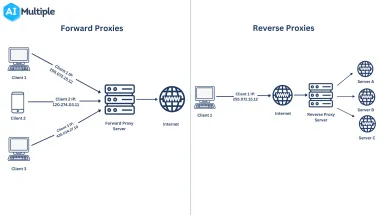
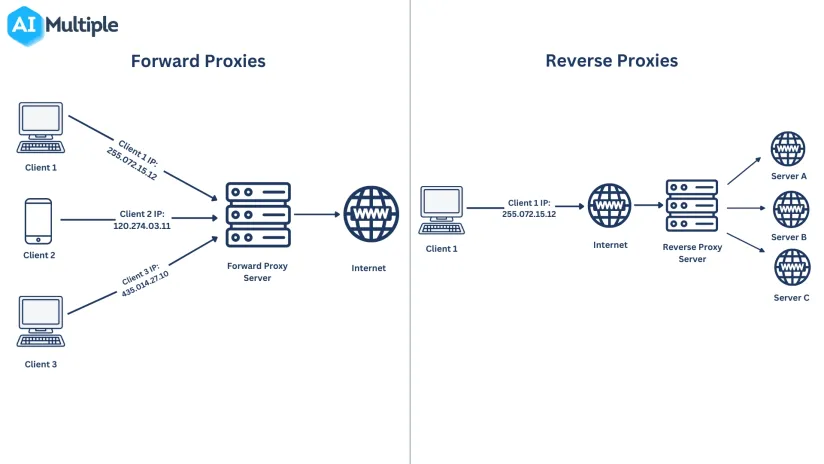
Forward and reverse proxies mask clients’ IP addresses to prevent their identities from being revealed. The location of the proxy server distinguishes forward and reverse proxies. These technologies have different purposes and follow different processes.
This article will explain the primary distinctions between forward and reverse proxies in terms of their applications, benefits, and purposes.
What is a forward proxy?
A forward proxy, also known as a regular proxy or proxy server, is used to receive and forward client connection requests to a destination web server through a server. The two most common types of proxy servers are datacenter and residential proxies. A forward proxy server is placed in front of clients. (see Figure 1).
To explore other types of proxies and their benefits, see our article on the types of proxy servers.
Figure 1: Representation of a forward proxy process.
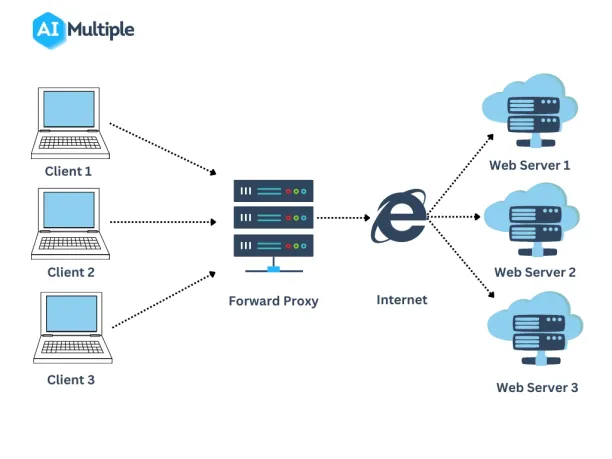
What is a reverse proxy?
A reverse proxy is a server that is positioned in front of web servers to ensure the security of incoming data from external sources. It accepts and receives incoming traffic on behalf of clients (see Figure 2).
Figure 2:
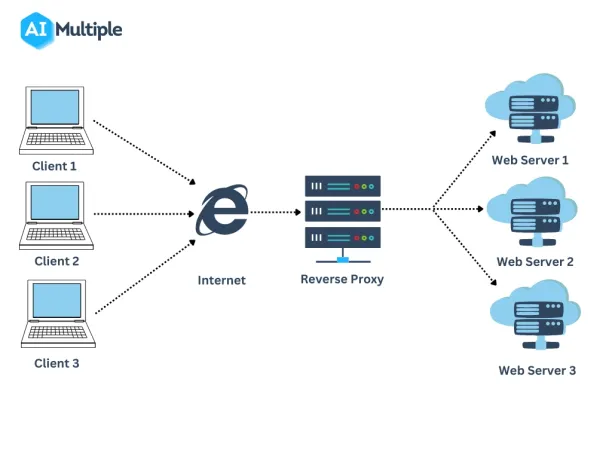
How does a forward and reverse proxy work?
Forward proxy
A forward proxy server sits between clients and the internet to establish a connection with the internet on behalf of the clients. Forward proxies, unlike reverse proxies, receive connection requests from clients and check connection requests to ensure the requests are valid before forwarding them to the target website.
- If the client’s connection request is valid, the forward proxy server will forward the request to the destination on the client’s behalf.
- If the client’s connection request is invalid, the forward proxy server will redirect it to the client without processing it.
A forward proxy monitors network traffic on both the client and web server sides. This means that all data from clients and web servers is routed through a forward proxy server. To prevent direct communication between the client’s computer and the target website, a forward proxy server receives requests from clients and forwards them to the target site, which then receives the provided information from the target site and forwards it to the client.
Reverse proxy
- A client sends the connection request to the internet.
- Instead of connecting the client directly to the web server, the internet forwards the client’s connection request to a reverse proxy.
- The reverse proxy communicates with the web server.
- The web server provides the requested information to the reverse proxy.
- The response from the origin server is received by the reverse proxy and sent to the client.
With a forward proxy, the web server does not know which client makes connection requests to the server. Because a forward proxy sits in front of the client and forwards the client’s request to the web server on their behalf.
With a reverse proxy, the client has no idea which web server they are connecting to since the proxy sits in front of the web server.
Top 5 benefits of reverse and forward proxies
Reverse proxies
1. Load balancing
A reverse proxy distributes the incoming client traffic equally among the website back-end servers to ensure no single server is getting overloaded (see Figure 3). Amazon, for example, is one of the most popular e-commerce websites. It most likely receives a large amount of incoming traffic every second. It is difficult to handle all of this incoming traffic with a single origin server. Otherwise, the server will become overloaded and be unavailable. Reverse proxies help website owners balance their high volume of incoming traffic across multiple origin servers.
Figure 3: Representation of a reverse proxy process.
2. Caching
Reverse proxies help clients cache frequently requested data on servers located near them for future requests. Caching allows clients to access the content more quickly. You do not have to visit the same website every time you need information. Instead, a reverse proxy retrieves and stores data for you so that you can reuse it with faster access.
3. SSL encryption
A reverse proxy can decrypt incoming client traffic and encrypt outgoing web server traffic (TLS/ SSL). All communications between web servers and clients are encrypted to ensure that no one can understand the information shared between servers and clients. This protects sensitive data against unauthorized networks.
Forward proxies
4. An additional layer of security
Forward proxies act as a security barrier between clients and the internet to protect clients’ computers from any cyberattacks. A proxy server monitors incoming and outgoing traffic in a network system to detect suspicious activities and protect client data. It performs similarly to a firewall, but there are significant differences in the methods and techniques that they employ.
5. Webpage Crawl Rate
The crawl rate is the number of requests a web scraping bot can make to a website per minute, hour, or day. Crawl rates are set by websites to limit web scraping activities. If you make requests frequently to the same website, the website will detect your activities as suspicious and block your IP address from accessing the content.
A proxy server allows businesses to collect large amounts of data while keeping scrapers anonymous. For instance, rotating proxies (a type of forward proxy) constantly change clients’ IP addresses with each new request to avoid website crawl rates.
To explore how to tackle web scraping challenges in more detail, read our in-depth guide on web scraping best practices.
Sponsored
Websites check clients’ IP addresses for each connection request and monitor their behavior while browsing web pages. They can distinguish between human and automated activities by detecting unusually high volumes of requests. Bright Data’s rotating proxies assign a new IP address to clients for each connection request to keep clients anonymous.
Top 5 use cases of forward and reverse proxies
Forward proxies
1. Perform A/B testing for product pricing
Assume your company has launched a new product or service. You want to optimize your own pricing strategy based on current market conditions. To determine the ideal price for the product or service (price testing), you must collect a massive amount of product price data from websites. A web scraping bot can help you speed up and improve your data collection process. However, most websites employ anti-scraping techniques such as IP bans and CAPTCHAs to prevent web scraping activities. To overcome web scraping challenges, you can integrate a proxy server into your scraper.
2. Bypass Internet Censorship and Filtering
Websites that use IP-based geolocation can determine your geographic location and restrict access to Internet content based on users’ geolocation. For example, governments censor certain websites and their content to prevent their citizens from accessing illegal websites. Individuals or private institutions can also conduct censorship for business and economic reasons. Businesses, for example, may use censorship to prevent the spread of misleading information or fake news about their brands.
A proxy server hides users’ real IP address to prevent them from being detected and tracked while browsing. It also allows users to access geo-restricted websites and content regardless of their location.
Reverse proxies
3. Improve the website’s performance
Reverse proxies can be used to cache website content in order to reduce the load on internet servers and improve website responsiveness. When a user visits a web page for the first time, the reverse proxy caches and saves web content such as images, videos, text, and so on for later use. Next time a user visits the same web page, the reverse proxy will be placed in front of the web server and will forward the cached version of the previously visited web page to the user. This improves the performance of websites.
4. Prevent data breaches
Yahoo!, for example, was one of the victims of a data breach. In 2014, 5001 million Yahoo user accounts had been hacked, including names, email addresses, telephone numbers, dates of birth, etc. Encrypting data is one of the best practices that businesses can apply to protect their data from cybersecurity threats. Reverse proxies help businesses prevent data breach by encrypting transmitted data in network traffic.
5. Restrict access to certain web content
Businesses may want to have control over what content and websites their employees can access for business, societal, or moral reasons. A reverse proxy server can be used to restrict access to certain websites. For example, businesses can use reverse proxies to prevent access to specific URLs that may present a risk. If an employee attempts to connect to these specific websites, the reverse proxy will refuse the connection request.
Forward proxies vs. reverse proxies: the main differences
Figure 4: Forward and reverse proxy comparison chart
Forward proxies vs. reverse proxies: which one is better for your business?
Choosing between forward and reverse proxy depends on your needs and use cases. For example, if your website receives a high volume of incoming traffic every day, reverse proxies could be useful to handle all of this incoming traffic.
Forward proxies, on the other hand, are ideal for collecting large amounts of web data without the risk of being blocked if you want to collect data from the stock market to analyze pricing patterns and market trends.
More on proxies
If you want to learn more about web scraping and how it can benefit your business, feel free to read our articles on the topic:
- The Ultimate Guide to Proxy vs. VPN: Which One Is Better?
- HTTP vs SOCKS Proxies: Benefits and Technical Overview
- SEO Proxies: Overview, Use Cases, Benefits and Best Practices
Also, don’t forget to check out our sortable/filterable list of proxy service / server.
For guidance to choose the right tool, reach out to us:
External links
- 1. “Yahoo! data breaches“. Wikipedia 5 October 2022. Retrieved November 4, 2022.


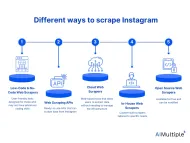
Comments
Your email address will not be published. All fields are required.